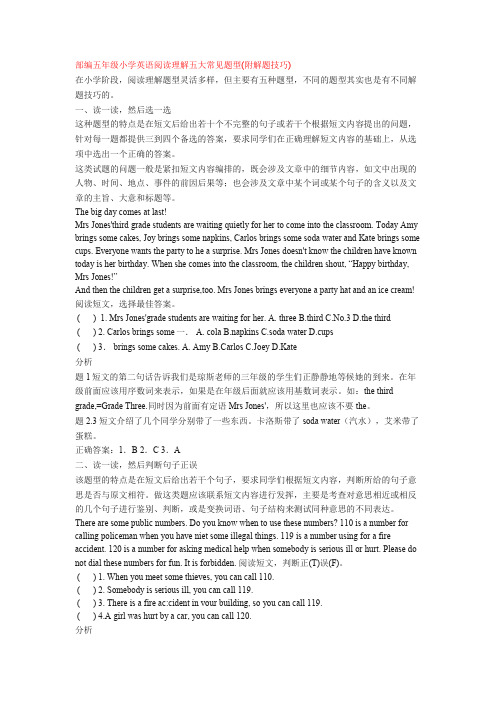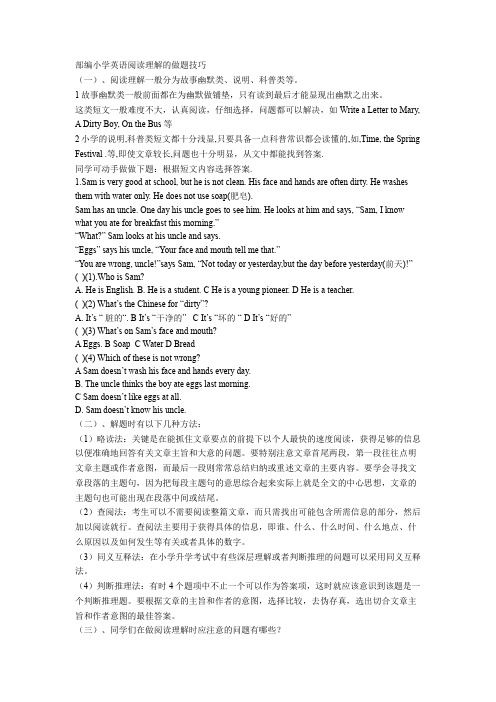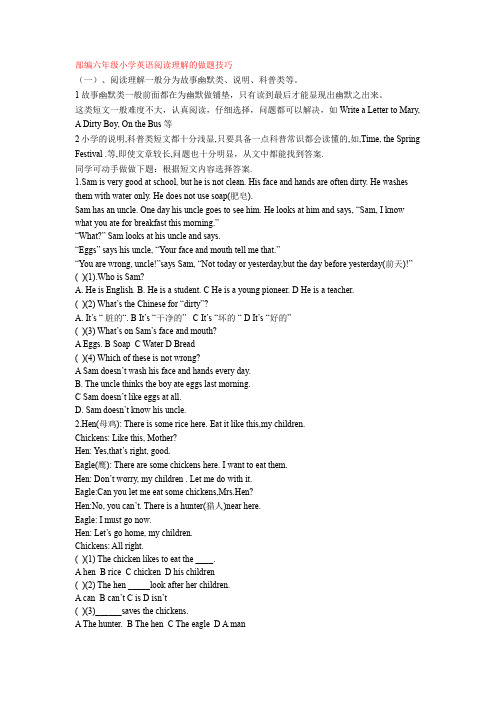小学英语 阅读理解的常见题型设置及解题技巧(附阅读材料)
六年级小学英语阅读理解的做题技巧+练习题(答案解析)

六年级小学英语阅读理解的做题技巧(一)、阅读理解一般分为故事幽默类、说明、科普类等。
1故事幽默类一般前面都在为幽默做铺垫,只有读到最后才能显现出幽默之出来。
这类短文一般难度不大,认真阅读,仔细选择,问题都可以解决,如Write a Letter to Mary, A Dirty Boy, On the Bus 等2小学的说明,科普类短文都十分浅显,只要具备一点科普常识都会读懂的,如,Time, the Spring Festival .等,即使文章较长,问题也十分明显,从文中都能找到答案.同学可动手做做下题:根据短文内容选择答案.1.Sam is very good at school, but he is not clean. His face and hands are often dirty. He washes them with water only. He does not use soap(肥皂).Sam has an uncle. One day his uncle goes to see him. He looks at him and says, “Sam, I know w hat you ate for breakfast this morning.”“What?” Sam looks at his uncle and says.“Eggs” says his uncle, “Your face and mouth tell me that.”“You are wrong, uncle!”says Sam, “Not today or yesterday,but the day before yesterday(前天)!”( )(1).Who is Sam?A. He is English.B. He is a student. C He is a young pioneer. D He is a teacher.( )(2) What’s the Chinese for “dirty”?A. It’s “ 脏的“. B It’s “干净的” C It’s “坏的“ D It’s “好的”( )(3) What’s on Sam’s face and mouth?A Eggs.B SoapC WaterD Bread( )(4) Which of these is not wrong?A Sam doesn’t wash his face and hands every day.B. The uncle thinks the boy ate eggs last morning.C Sam doesn’t like eggs at all.D. Sam doesn’t know his uncle.2.Hen(母鸡): There is some rice here. Eat it like this,my children.Chickens: Like this, Mother?Hen: Yes,that’s right, good.Eagle(鹰): There are some chickens here. I want to eat them.Hen: Don’t worry, my children . Let me do with it.Eagle:Can you let me eat some chickens,Mrs.Hen?Hen:No, you can’t. There is a hunter(猎人)near here.Eagle: I must go now.Hen: Let’s go home, my children.Chickens: All right.( )(1) The chicken likes to eat the ____.A henB riceC chickenD his children( )(2) The hen _____look after her children.A canB can’tC isD isn’t( )(3)______saves the chickens.A The hunter.B The henC The eagleD A man( )(4)The eagle can’t eat_____ at last.A the chickensB go.C the hunterD the hen(二)、解题时有以下几种方法:(1)略读法:关键是在能抓住文章要点的前提下以个人最快的速度阅读,获得足够的信息以便准确地回答有关文章主旨和大意的问题。
六年级小学英语阅读理解的常见题型设置及解题技巧+阅读理解专项练习含答案解析

六年级小学英语阅读理解的常见题型设置及解题技巧+阅读理解专项练习含答案解析部编六年级小学英语阅读理解的常见题型设置及解题技巧在小学阶段,阅读理解题型灵活多样,但主要有以下题型:一、读一读,然后选一选。
这种题型的特点是在短文后给出若十个不完整的句子或若干个根据短文内容提出的问题,针对每一题都提供三到四个备选的答案,要求同学们在正确理解短文内容的基础上,从选项中选出一个正确的答案。
这类试题的问题一般是紧扣短文内容编排的,既会涉及文章中的细节内容,如文中出现的人物、时间、地点、事件的前因后果等;也会涉及文章中某个词或某个句子的含义以及文章的主旨、大意和标题等。
The big day comes at last! Mrs Jones'third grade students are waiting quietly for her to come into the classroom. Today Amy brings some cakes, Joy brings some napkins, Carlos brings some soda water and Kate brings some cups. Everyone wants the party to he a surprise. Mrs Jones doesn't know the children have known today is her birthday. When she comes into the classroom, the children shout, “Happy birthday, Mrs Jones!” And then the children get a surprise,too. Mrs Jones brings everyone a party hat and an ice cream!阅读短文,选择最佳答案。
六年级小学英语阅读理解的常见题型设置及解题技巧+阅读理解专项练习含答案解析

六年级小学英语阅读理解的常见题型设置及解题技巧+阅读理解专项练习含答案解析部编六年级小学英语阅读理解的常见题型设置及解题技巧在小学阶段,阅读理解题型灵活多样,但主要有以下题型:一、读一读,然后选一选。
这种题型的特点是在短文后给出若十个不完整的句子或若干个根据短文内容提出的问题,针对每一题都提供三到四个备选的答案,要求同学们在正确理解短文内容的基础上,从选项中选出一个正确的答案。
这类试题的问题一般是紧扣短文内容编排的,既会涉及文章中的细节内容,如文中出现的人物、时间、地点、事件的前因后果等;也会涉及文章中某个词或某个句子的含义以及文章的主旨、大意和标题等。
The big day comes at last! Mrs Jones'third grade students are waiting quietly for her to come into the classroom. Today Amy brings some cakes, Joy brings some napkins, Carlos brings some soda water and Kate brings some cups. Everyone wants the party to he a surprise. Mrs Jones doesn't know the children have known today is her birthday. When she comes into the classroom, the children shout, “Happy birthday, Mrs Jones!” And then the children get a surprise,too. Mrs Jones brings everyone a party hat and an ice cream!阅读短文,选择最佳答案。
五年级小学英语阅读理解五大常见题型(附解题技巧)+练习题(答案解析)

部编五年级小学英语阅读理解五大常见题型(附解题技巧)在小学阶段,阅读理解题型灵活多样,但主要有五种题型,不同的题型其实也是有不同解题技巧的。
一、读一读,然后选一选这种题型的特点是在短文后给出若十个不完整的句子或若干个根据短文内容提出的问题,针对每一题都提供三到四个备选的答案,要求同学们在正确理解短文内容的基础上,从选项中选出一个正确的答案。
这类试题的问题一般是紧扣短文内容编排的,既会涉及文章中的细节内容,如文中出现的人物、时间、地点、事件的前因后果等;也会涉及文章中某个词或某个句子的含义以及文章的主旨、大意和标题等。
The big day comes at last!Mrs Jones'third grade students are waiting quietly for her to come into the classroom. Today Amy brings some cakes, Joy brings some napkins, Carlos brings some soda water and Kate brings some cups. Everyone wants the party to he a surprise. Mrs Jones doesn't know the children have known today is her birthday. When she comes into the classroom, the children shout, “Happy birthday, Mrs Jones!”And then the children get a surprise,too. Mrs Jones brings everyone a party hat and an ice cream!阅读短文,选择最佳答案。
( ) 1. Mrs Jones'grade students are waiting for her. A. three B.third C.No.3 D.the third( ) 2. Carlos brings some一. A. cola B.napkins C.soda water D.cups( ) 3. brings some cakes. A. Amy B.Carlos C.Joey D.Kate分析题1短文的第二句话告诉我们是琼斯老师的三年级的学生们正静静地等候她的到来。
小学英语英语阅读理解技巧和方法+阅读理解专项练习含答案解析

小学英语英语阅读理解技巧和方法+阅读理解专项练习含答案解析部编六年级小学英语英语阅读理解技巧和方法阅读理解题是英语考试必考的题型之一,但是阅读理解题常常又是学生最容易丢分的地方。
那么怎样才能在英语考试中阅读理解题少丢分甚至不丢分呢?一、先看问题,再读原文这个是我做阅读理解题的一个习惯,先看问题,带着问题去原文里找答案,这样比较有目的性。
现在问题的形式也比较灵活,有单选,有判断正误,还有回答问题。
先了解问题具体是哪种形式,在阅读原文的时候才更有针对性寻找答案。
小学阶段的阅读理解相对来说还是比较简单的,很多问题可以在原文里直接找到答案,当然这主要是针对单选和判断来说的。
先读问题,在阅读原文的时候有的问题一下子就出来了,节约了很多时间。
二、通读全文,抓住重点在阅读原文的时候一定不要一句一句的看,一句一句的理解,这样做会影响对整篇文章的理解和认识。
如果遇上生词,先不要管它,略过生词继续通读全文。
读完一遍能够大概明白文章讲了一件什么事。
在阅读的过程中还要注意抓住重点,即出现了哪些人物,提到了什么时间,说到了哪个地点,发生了什么事情,这些关键词最好能用笔在原文中做个记号,因为后面的问题一般都和这些关键词相关。
三、大胆猜词,掌握意思说阅读理解题难很大程度上是因为句子中有些单词不知道是什么意思,这在理解文章意思的时候就会加大难度。
但是我们可以通过猜测单词的意思对通篇文章进行理解,可以根据上下文的意思进行猜测,还可以根据单词的构成进行猜测,比如说我们知道happy是“高兴的”,那么unhappy就是“不高兴的”。
当然这就需要学生在平时注意单词的构成。
四、反复阅读,深刻理解做阅读理解题一般需要读两到三遍,这样对理解全文是非常有帮助的。
第一次阅读把那些能够直接找出答案的题做出来,第二遍阅读就要明白原文具体说了一件什么事情,面白了这个时候对后面一些需要理解能回答的问题这时候就可以解决了。
第三遍通读全文,对所做出的答案再确认一遍。
小学英语阅读理解的常见题型设置及解题技巧+阅读理解专项练习含答案解析

小学英语阅读理解的常见题型设置及解题技巧+阅读理解专项练习含答案解析部编六年级小学英语阅读理解的常见题型设置及解题技巧在小学阶段,阅读理解题型灵活多样,但主要有以下题型:一、读一读,然后选一选。
这种题型的特点是在短文后给出若十个不完整的句子或若干个根据短文内容提出的问题,针对每一题都提供三到四个备选的答案,要求同学们在正确理解短文内容的基础上,从选项中选出一个正确的答案。
这类试题的问题一般是紧扣短文内容编排的,既会涉及文章中的细节内容,如文中出现的人物、时间、地点、事件的前因后果等;也会涉及文章中某个词或某个句子的含义以及文章的主旨、大意和标题等。
The big day comes at last! Mrs Jones'third grade students are waiting quietly for her to come into the classroom. Today Amy brings some cakes, Joy brings some napkins, Carlos brings some soda water and Kate brings some cups. Everyone wants the party to he a surprise. Mrs Jones doesn't know the children have known today is her birthday. When she comes into the classroom, the children shout, “Happy birthday, Mrs Jones!” And then the children get a surprise,too. Mrs Jones brings everyone a party hat and an ice cream!阅读短文,选择最佳答案。
小学英语阅读理解的做题技巧+专项训练练习题(含答案解析)

部编小学英语阅读理解的做题技巧(一)、阅读理解一般分为故事幽默类、说明、科普类等。
1故事幽默类一般前面都在为幽默做铺垫,只有读到最后才能显现出幽默之出来。
这类短文一般难度不大,认真阅读,仔细选择,问题都可以解决,如Write a Letter to Mary, A Dirty Boy, On the Bus 等2小学的说明,科普类短文都十分浅显,只要具备一点科普常识都会读懂的,如,Time, the Spring Festival .等,即使文章较长,问题也十分明显,从文中都能找到答案.同学可动手做做下题:根据短文内容选择答案.1.Sam is very good at school, but he is not clean. His face and hands are often dirty. He washes them with water only. He does not use soap(肥皂).Sam has an uncle. One day his uncle goes to see him. He looks at him and says, “Sam, I knowwh at you ate for breakfast this morning.”“What?” Sam looks at his uncle and says.“Eggs” says his uncle, “Your face and mouth tell me that.”“You are wrong, uncle!”says Sam, “Not today or yesterday,but the day before yesterday(前天)!”( )(1).Who is Sam?A. He is English.B. He is a student. C He is a young pioneer. D He is a teacher.( )(2) What’s the Chinese for “dirty”?A. It’s “ 脏的“. B It’s “干净的” C It’s “坏的“ D It’s “好的”( )(3) What’s on Sam’s face and mouth?A Eggs.B SoapC WaterD Bread( )(4) Which of these is not wrong?A Sam doesn’t wash his face and hands every day.B. The uncle thinks the boy ate eggs last morning.C Sam doesn’t like eggs at all.D. Sam doesn’t know his uncle.(二)、解题时有以下几种方法:(1)略读法:关键是在能抓住文章要点的前提下以个人最快的速度阅读,获得足够的信息以便准确地回答有关文章主旨和大意的问题。
部编六年级小学英语阅读理解的做题技巧+练习题(答案解析)

部编六年级小学英语阅读理解的做题技巧(一)、阅读理解一般分为故事幽默类、说明、科普类等。
1故事幽默类一般前面都在为幽默做铺垫,只有读到最后才能显现出幽默之出来。
这类短文一般难度不大,认真阅读,仔细选择,问题都可以解决,如Write a Letter to Mary, A Dirty Boy, On the Bus 等2小学的说明,科普类短文都十分浅显,只要具备一点科普常识都会读懂的,如,Time, the Spring Festival .等,即使文章较长,问题也十分明显,从文中都能找到答案.同学可动手做做下题:根据短文内容选择答案.1.Sam is very good at school, but he is not clean. His face and hands are often dirty. He washes them with water only. He does not use soap(肥皂).Sam has an uncle. One day his uncle goes to see him. He looks at him and says, “Sam, I know what you ate for breakfast this morning.”“What?” Sam looks at his uncle and says.“Eggs” says his uncle, “Your face and mouth tell me that.”“You are wrong, uncle!”says Sam, “Not today or yesterday,but the day before yesterday(前天)!”( )(1).Who is Sam?A. He is English.B. He is a student. C He is a young pioneer. D He is a teacher.( )(2) What’s the Chinese for “dirty”?A. It’s “ 脏的“. B It’s “干净的” C It’s “坏的“ D It’s “好的”( )(3) What’s on Sam’s face and mouth?A Eggs.B SoapC WaterD Bread( )(4) Which of these is not wrong?A Sam doesn’t wash his face and hands every day.B. The uncle thinks the boy ate eggs last morning.C Sam doesn’t like eggs at all.D. Sam doesn’t know his uncle.2.Hen(母鸡): There is some rice here. Eat it like this,my children.Chickens: Like this, Mother?Hen: Yes,that’s right, good.Eagle(鹰): There are some chickens here. I want to eat them.Hen: Don’t worry, my children . Let me do with it.Eagle:Can you let me eat some chickens,Mrs.Hen?Hen:No, you can’t. There is a hunter(猎人)near here.Eagle: I must go now.Hen: Let’s go home, my children.Chickens: All right.( )(1) The chicken likes to eat the ____.A henB riceC chickenD his children( )(2) The hen _____look after her children.A canB can’tC isD isn’t( )(3)______saves the chickens.A The hunter.B The henC The eagleD A man( )(4)The eagle can’t eat_____ at last.A the chickensB go.C the hunterD the hen(二)、解题时有以下几种方法:(1)略读法:关键是在能抓住文章要点的前提下以个人最快的速度阅读,获得足够的信息以便准确地回答有关文章主旨和大意的问题。
- 1、下载文档前请自行甄别文档内容的完整性,平台不提供额外的编辑、内容补充、找答案等附加服务。
- 2、"仅部分预览"的文档,不可在线预览部分如存在完整性等问题,可反馈申请退款(可完整预览的文档不适用该条件!)。
- 3、如文档侵犯您的权益,请联系客服反馈,我们会尽快为您处理(人工客服工作时间:9:00-18:30)。
小学英语阅读理解的常见题型设置及解题技巧在小学阶段,阅读理解题型灵活多样,但主要有以下题型:一、读一读,然后选一选。
这种题型的特点是在短文后给出若十个不完整的句子或若干个根据短文内容提出的问题,针对每一题都提供三到四个备选的答案,要求同学们在正确理解短文内容的基础上,从选项中选出一个正确的答案。
这类试题的问题一般是紧扣短文内容编排的,既会涉及文章中的细节内容,如文中出现的人物、时间、地点、事件的前因后果等;也会涉及文章中某个词或某个句子的含义以及文章的主旨、大意和标题等。
The big day comes at last! Mrs Jones' third grade students are waiting quietly for her to come into the classroom. Today Amy brings some cakes, Joy brings some napkins, Carlos brings some soda water and Kate brings some cups. Everyone wants the party to he a surprise. Mrs Jones doesn't know the children have known today is her birthday. When she comes into the classroom, the children shout,“Happy birthday, Mrs Jones!”And then the children get a surprise,too. Mrs Jones brings everyone a party hat and an ice cream!阅读短文,选择最佳答案。
( ) 1. Mrs Jones' grade students are waiting for her.A. threeB.thirdC.No.3D.the third( )2. Carlos brings some _____ .A. colaB.napkinsC.soda waterD.cups( )3._____ brings some cakes.A. AmyB.CarlosC.JoeyD.Kate分析题1短文的第二句话告诉我们是琼斯老师的三年级的学生们正静静地等候她的到来。
在年级前面应该用序数词来表示,如果是在年级后面就应该用基数词表示。
如:the third grade,=Grade Three.同时因为前面有定语Mrs Jones',所以这里也应该不要the。
题2.3 短文介绍了几个同学分别带了一些东西。
卡洛斯带了soda water(汽水),艾米带了蛋糕。
正确答案:1.B 2.C 3. A二、读一读,然后判断句子正误。
该题型的特点是在短文后给出若干个句子,要求同学们根据短文内容,判断所给的句子意思是否与原文相符。
做这类题应该联系短文内容进行发挥,主要是考查对意思相近或相反的几个句子进行鉴别、判断,或是变换词语、句子结构来测试同种意思的不同表达。
There are some public numbers. Do you know when to use these numbers?110 is a number for calling policeman when you have meet some illegal things.119 is a number using for a fire accident.120 is a number for asking medical help when somebody is serious ill or hurt.Please do not dial these numbers for fun. It is forbidden.阅读短文,判断正(T)误(F)。
( )1. When you meet some thieves, you can call 110.( )2. Somebody is serious ill, you can call 119.( )3. There is a fire accident in your building, so you can call 119.( )4.A girl was hurt by a car, you can call 120.分析这篇短文是介绍几个常用电话号码的用法。
读懂就会判断句子的正误了。
题l 意思是当你遇到小偷的时候,你应该拔打110。
110是遇到违法事件时的报警号码,所以判断它是正确的。
题2意思是有人得了重病,你应该拔打119。
1 19是发生火灾时的求救号码,所以判断它是错误的。
题3意思是当你的房子发生了火灾,你应该拨打119。
可以判断它是正确的,题4意思是一个女孩被汽车撞了,你应该拔打120。
120是请求医疗急救的号码,应该先送她去医院+,所以可以判断它是正确的。
正确答案:1.T 2.F 3.T 4.T三、读一读,然后回答问题。
这种题型要求根据所提的问题写出完整、正确的句子。
这样的题目听起来似乎很难,其实真正做起来却很简单。
回答问题时,句子越简单越好,答案应简洁明了,能用一个词,就不用两个词,只要能说明问题就行。
There are seven days in a week. They are Sunday, Monday, Tuesday, Wednesday, Thursday, Friday and Saturday. Sunday is the first day of the week. Saturday and Sunday are the weekend. Usually, we have a rest on the weekends.The other five days are weekdays. We usually go to school or work during weekdays. Nobody likes Monday, because we have a good time on Sunday and we don't want to study or work any more.阅读短文,然后根据短文内容回答问题。
1. How many days are there in a week?2. What are they?3. What is the first day of the week?4. What is the weekend?5. When do we usually go to school?分析题1 问一周有几天。
用一个seven就可以回答了。
题2问分别是哪几天。
短文第二句已经给我们答案了。
题3记住一周的第一天是星期天而不是星期一。
题4周末是星期六和星期天。
题5 问我们通常什么时候上学。
应该是工作日了。
正确答案:1. There are seven. 2. They are Sunday, Monday, Tuesday, Wednesday, Thursday, Friday and Saturday.3.Sunday.4.Saturday and Sunday.5.During weekdays.四、读一读,然后根据短文内容填空。
该题型的特点是在短文后给出一篇经过改写或缩写后与原短文意思相同的短文或几个句子,在短文或句子中均留有若干个空格,要求同学们在每一个空格处填上一个词,使短文或句子所表达的意思与原短文的内容一致。
The English people like take-away food. The most popular food is fish and chips.They usually go to a fish and chips shop. They put the food in paper bags, and takeit home, or to their work place. At lunch time, many people eat takeaway food inthe park. Chinese take-away food is also very popular in England. People in the USAand Australia like Chinese take-away food, too. But the most popular food in theUSA is fried chicken.阅读短文,然后填空。
1. The most popular food in England is______.2. They put the food in______ ,and take it home, or to their work place.3. At lunch time, many people eat______food in the park.4. Chinese take-away food is also very______ in England.5. The most popular food in the USA is______.分析题l 第二句话告诉我们最受英国人欢迎的食物是鱼和薯片。
题2第四句话告诉我们他们把食物装进纸袋里,然后带回家或工作的地方。
题3短文还告诉我们在午餐的时候,很多人喜欢在公园里吃可携带食物。
题4第二段告诉我们中国的可携带食物在英国也很受欢迎。
题5最后一句话告诉我们在美国,最受欢迎的食物是炸鸡。
正确答案:1.fish and chips 2.paper bags 3.take-away4.popular 5.fried chicken五、读一读,然后画一画。
该题型要求同学们先读懂短文,然后根据短文内容画与短文内容相关的。
要注意短文中提到的一些东西要在画中体现出来。
Aunt Mary is coming, but Tom's mother is too busy to pick her up. So she asksTom to pick aunt Mary up. But Tom did not meet her for a long time. So his motherasks Tom to find as following:She is at the bus station. She is a tall woman with long black hair. She is wearing a green dress, a brown hat and a pair of boots. She is holding a handbag.Can Tom find her aunt?根据汤姆的妈妈的描述给玛丽阿姨画一幅画,以便汤姆更容易找到她。
